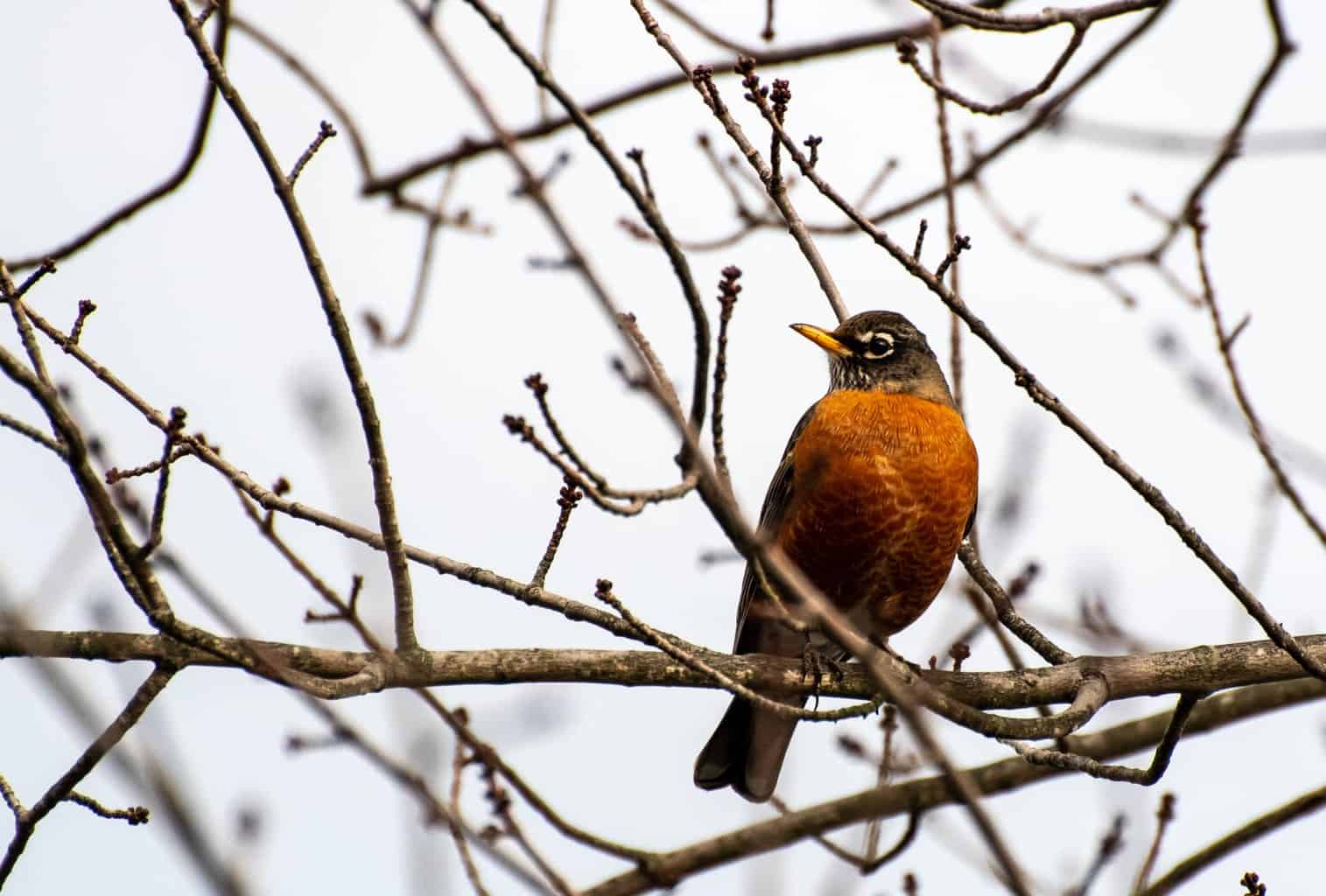Thanks to the massive number of diners scattered all over the state, New Jersey is known as the Diner Capital of the world.
But the four physical regions of the state are also home to some of the most beautiful bird species that bird lovers can watch all year long.
As of April 2021, 485 bird species have been recorded in New Jersey. Some of these birds are permanent residents, while others only visit in summer or winter during migration season.
In this article, we’ll talk about the most famous types of birds in New Jersey and where to find them if you’re interested in studying their beautiful features and exceptional behavior. So, keep on reading to learn more about them.
Red Birds in New Jersey
Red-Headed Woodpecker
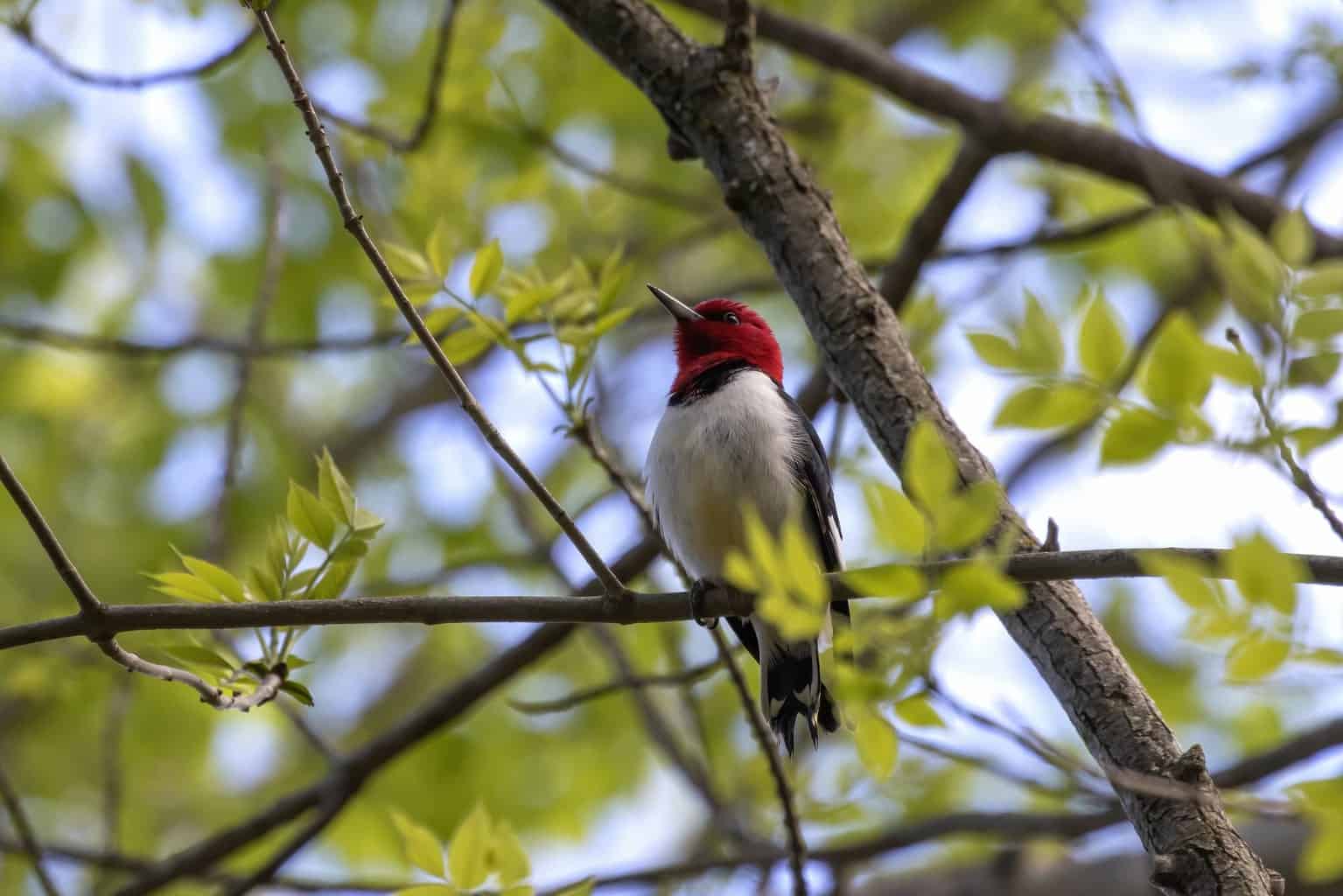
- Scientific Name: Melanerpes Erythrocephalus
- Length: Between 7.5 and 9.8 inches
- Weight: Between 2 and 3.4 ounces
- Wingspan: About 16.7 inches
The woodpecker’s red head makes it easy to notice. It has a black body and a white belly and catches insects while flying, unlike other woodpeckers that excavate for food.
In northern New Jersey, the Red-Headed Woodpecker can be found in wetland forests, while it’s abundant in southern oak and pine forests with a ground cover of blueberries.
In addition to bugs, this familiar bird also feeds on seeds, berries, nuts, and small rodents or young birds.
House Finch
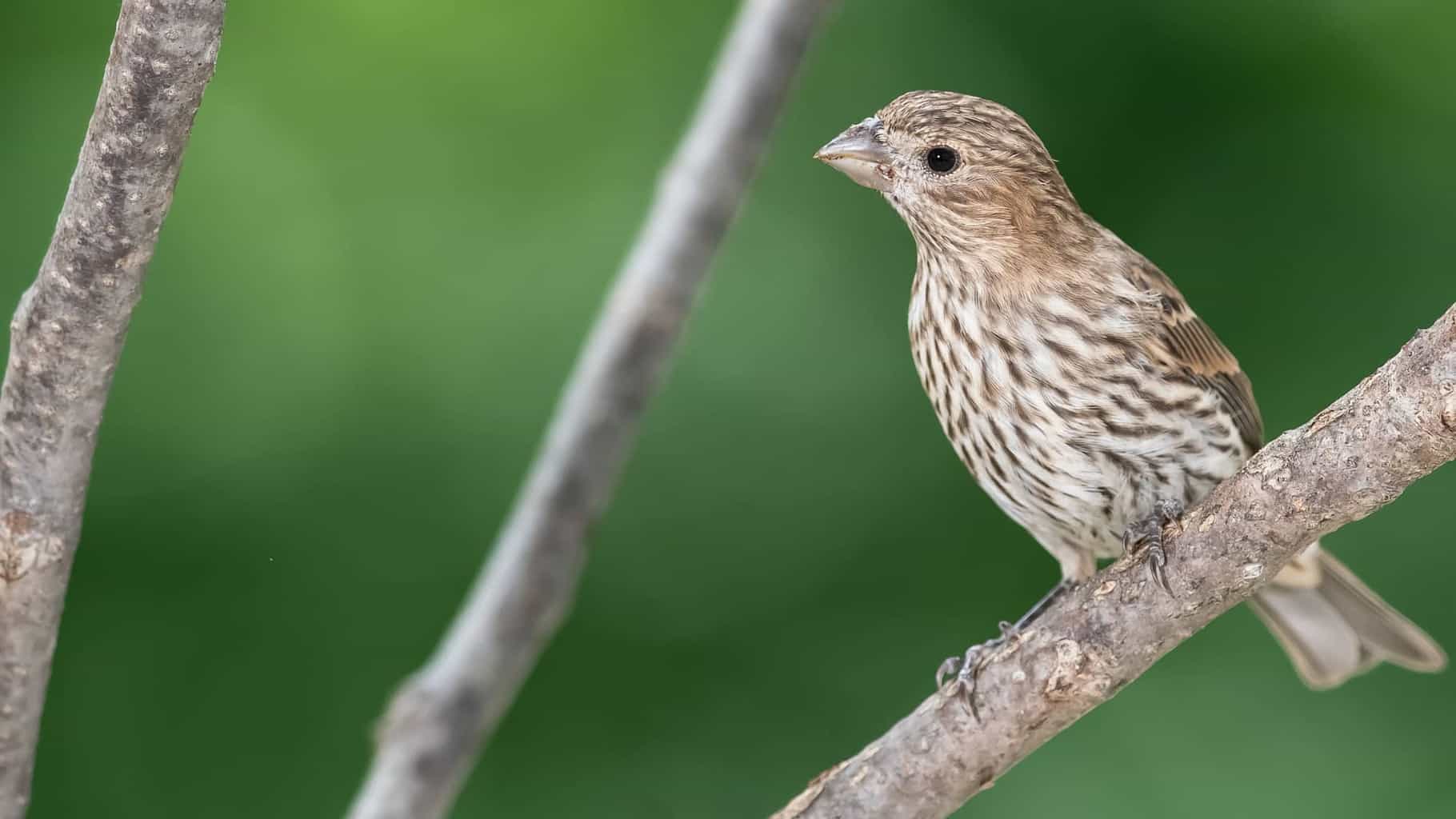
- Scientific Name: Haemorhous Mexicanus
- Length: Between 5 and 6 inches
- Weight: Between 0.6 and 0.9 ounces
- Wingspan: Between 8 and 10 inches
The House Finch is a common bird to find in New Jersey, usually visiting backyard bird feeders or crushing seeds on the ground. Male birds have red faces that make them easy to spot, but the females have paler bodies that are mostly brownish-gray.
The red color in the bird’s feathers is related to the amount of red dye in its food. Therefore, females usually prefer to mate with the reddest male.
It exclusively eats plant material, including seeds and buds. It also feeds on fruits like cherries, apricots, plums, strawberries, and figs.
Northern Cardinal
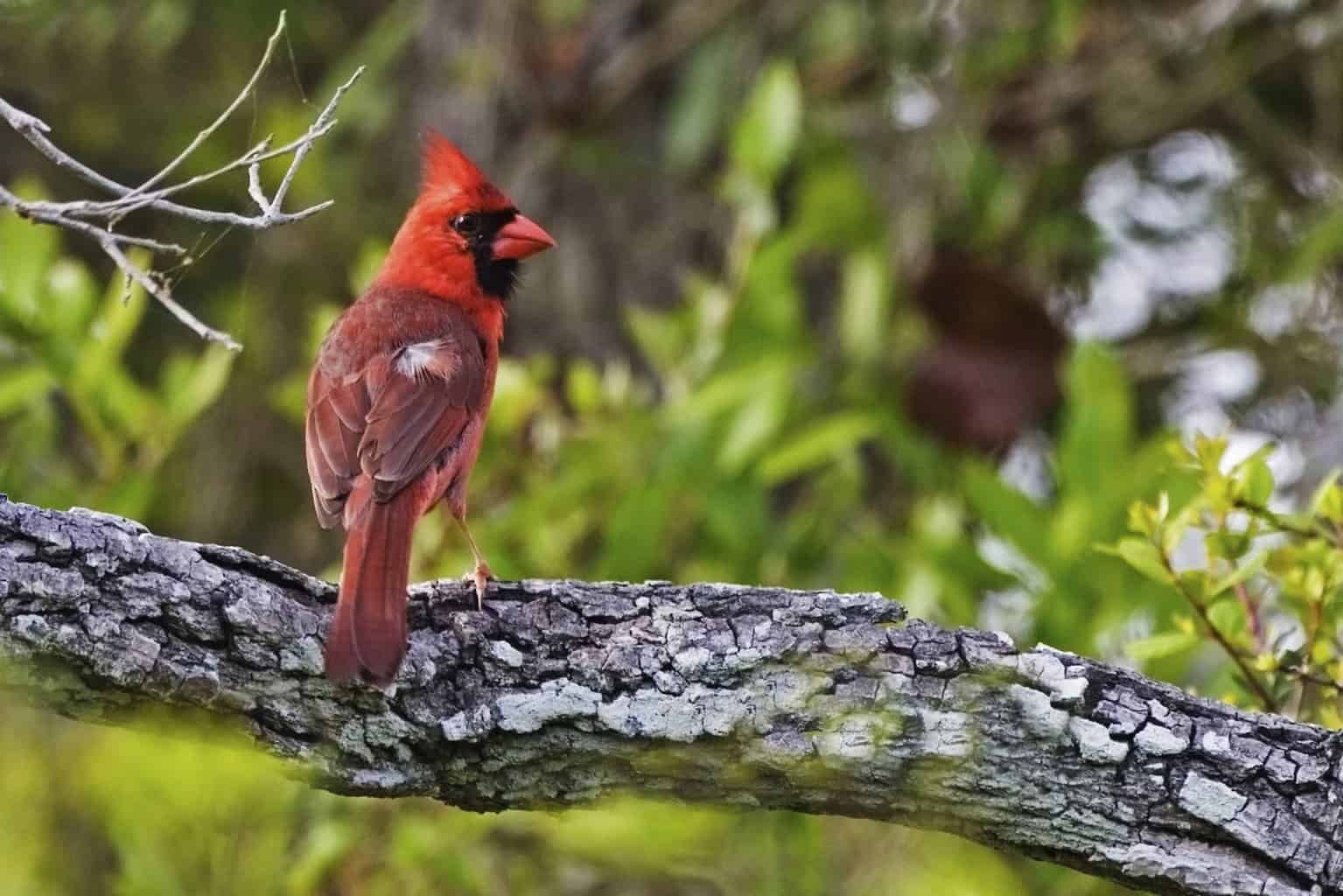
- Scientific Name: Cardinalis Cardinalis
- Length: Between 8.3 and 9.1 inches
- Weight: Between 1.9 and 2.29 ounces
- Wingspan: Between 9.8 and 12.2 inches
The Northern Cardinal is one of the easiest songbirds to find in New Jersey. The bird is covered with bright red plumage and a black mask surrounding the bill.
This common backyard bird mainly feeds on seeds and fruits like blackberry, mulberry, buckwheat, and corn. It has several favorite foods and feeds on grass and bugs like butterflies, moths, spiders, and beetles.
Red-Bellied Woodpecker
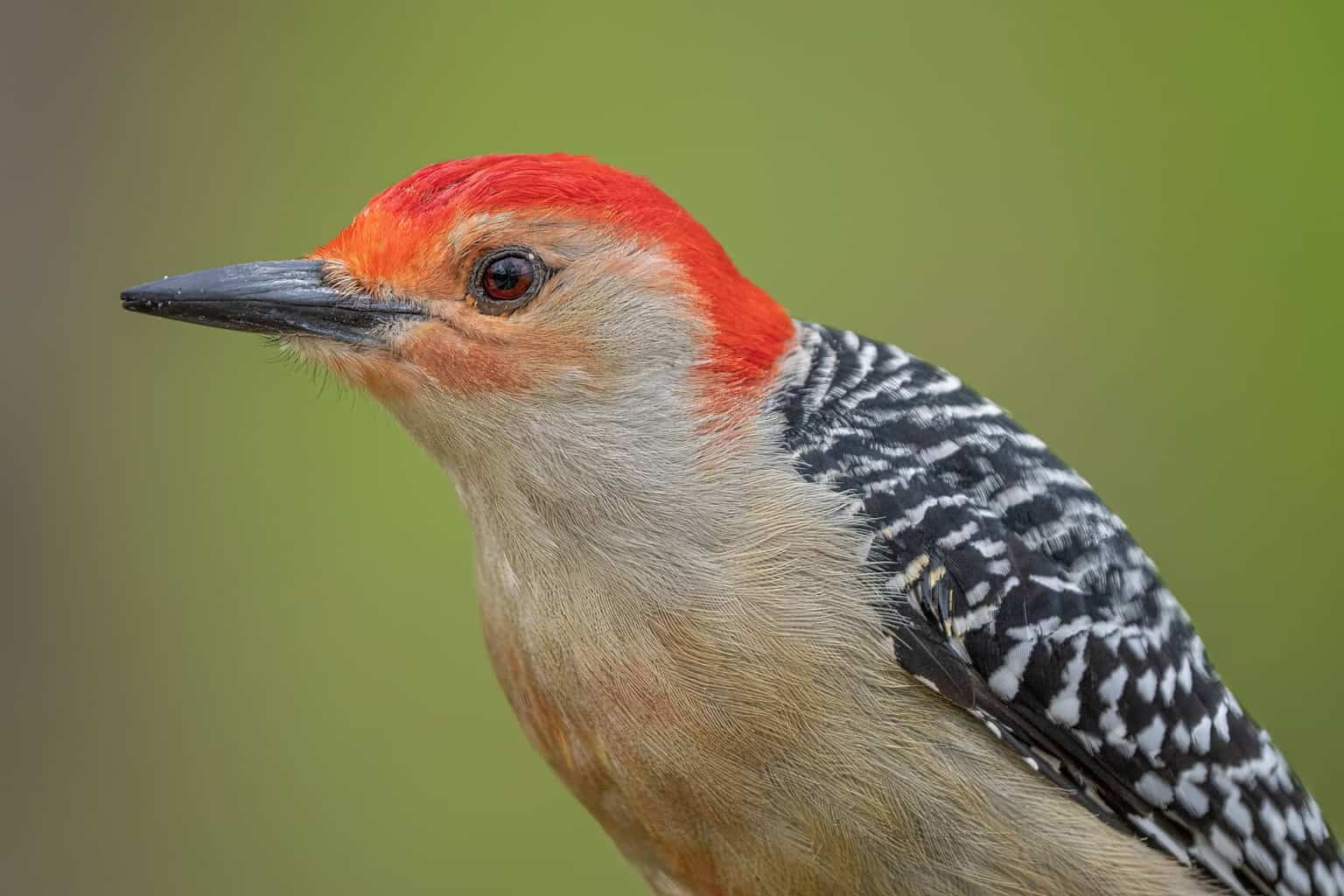
- Scientific Name: Melanerpes Carolinus
- Length: Between 9 to 10.5 inches
- Weight: Between 2 and 3.2 ounces
- Wingspan: Between 15 and 18 inches
Since the massive forest clearing of the 19th century, the numbers of the Red-Bellied Woodpecker have declined in New Jersey. Today, you can find these bold birds around a big bird feeding station where they prefer to look for food.
The Red-Bellied Woodpecker is usually mistaken for the Red-Headed Woodpecker, which is larger. The bird clings to tree trunks and uses its short stiff tail to balance whole it sticks its barbed-tip tongue into the crevices of dead trees to find larvae.
Red Crossbill
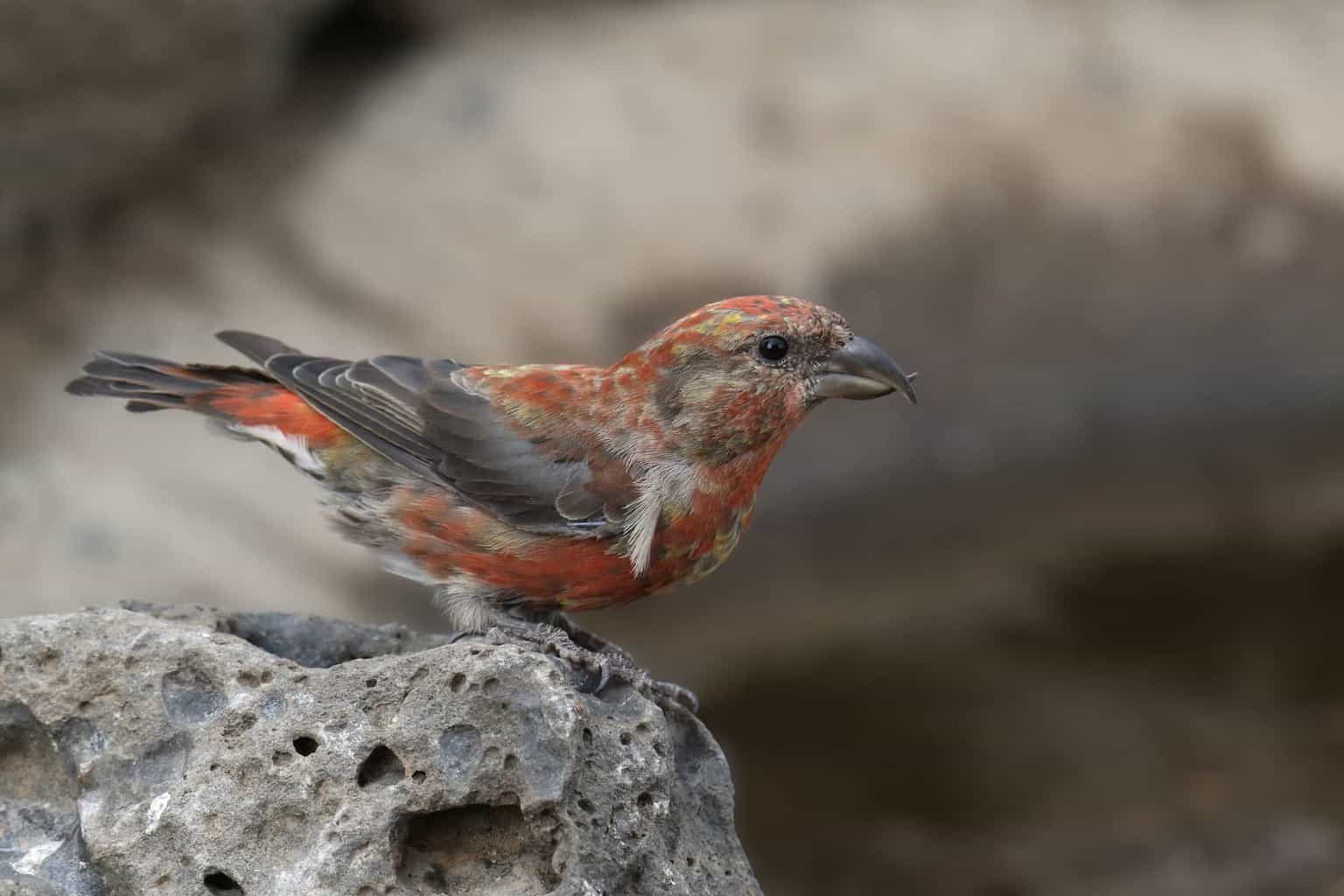
- Scientific Name: Loxia Curvirostra
- Length: About 8 inches
- Weight: Between 1.4 and 1.8 ounces
- Wingspan: About 11 inches
Red Crossbills usually forage in groups and visit feeders that offer sunflower seeds. They typically feed on the nutritious seeds in pine forests, using their strong bills to break into the unopened cones.
The male Red Crossbill has an overall brick red body with darker feathers on the tail and wings. Female birds are usually yellowish-brown.
Unlike other birds, Red Crossbills can breed even in winter if they find a large cone crop as they depend on conifer seeds for food.
Red-Winged Blackbird
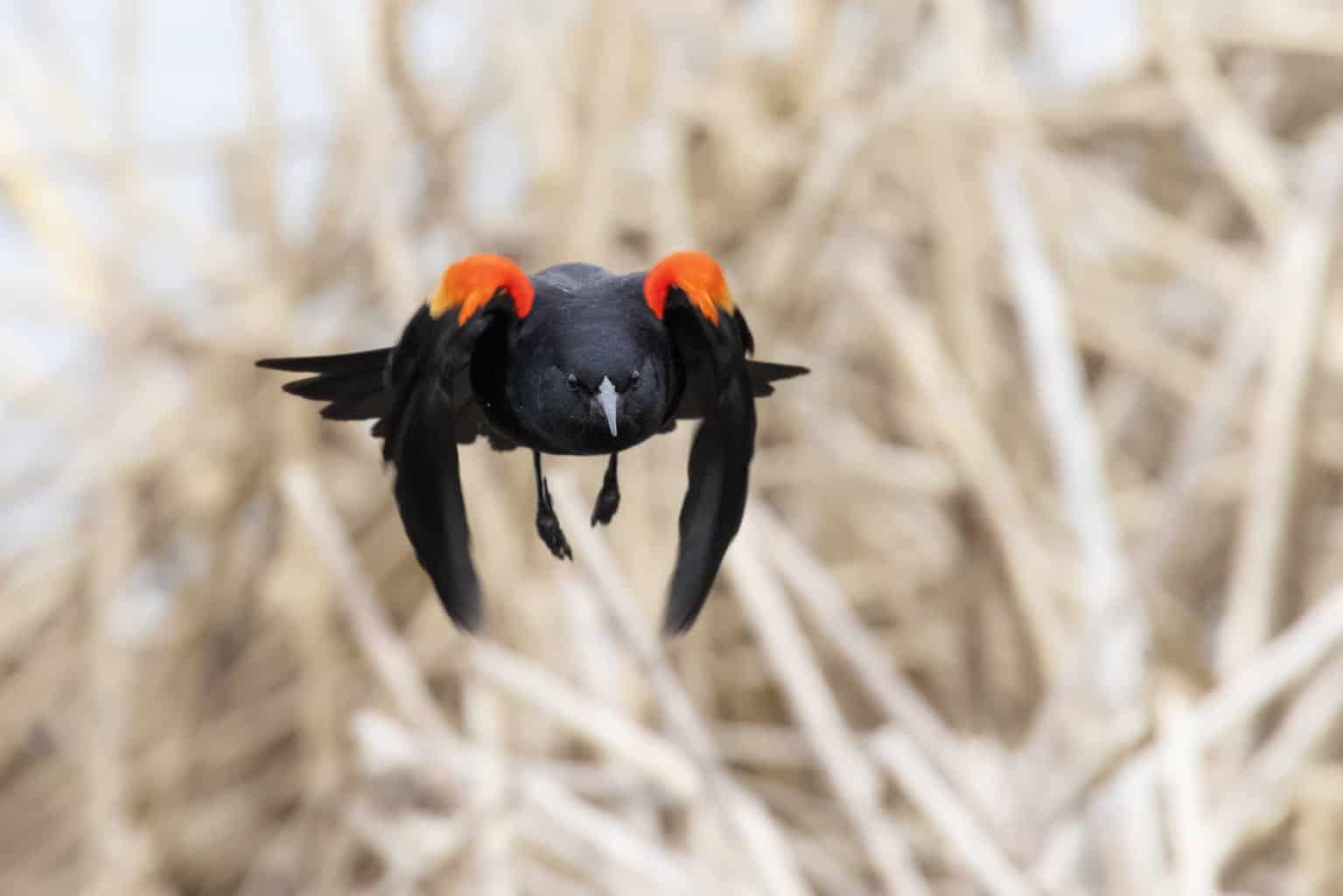
- Scientific Name: Agelaius Phoeniceus
- Length: Between 6.7 and 9.1 inches
- Weight: Between 1.1 and 2.7 ounces
- Wingspan: Between 12.2 and 15.8 inches
If you’re exploring the marshes of New Jersey, you will most likely meet at least one family of Red-Winged Blackbirds. Male birds have glossy black bodies with red and yellow shoulder badges, while female birds have brownish-streaked bodies.
Male birds can have as many as 15 female mates, and they usually engage in territorial fights with other males.
The bird feeds on various types of seeds and insects in the summer. In winter, the Red-Winged Blackbird probes the roots of aquatic plants to feed on the insects hiding inside.
Redhead
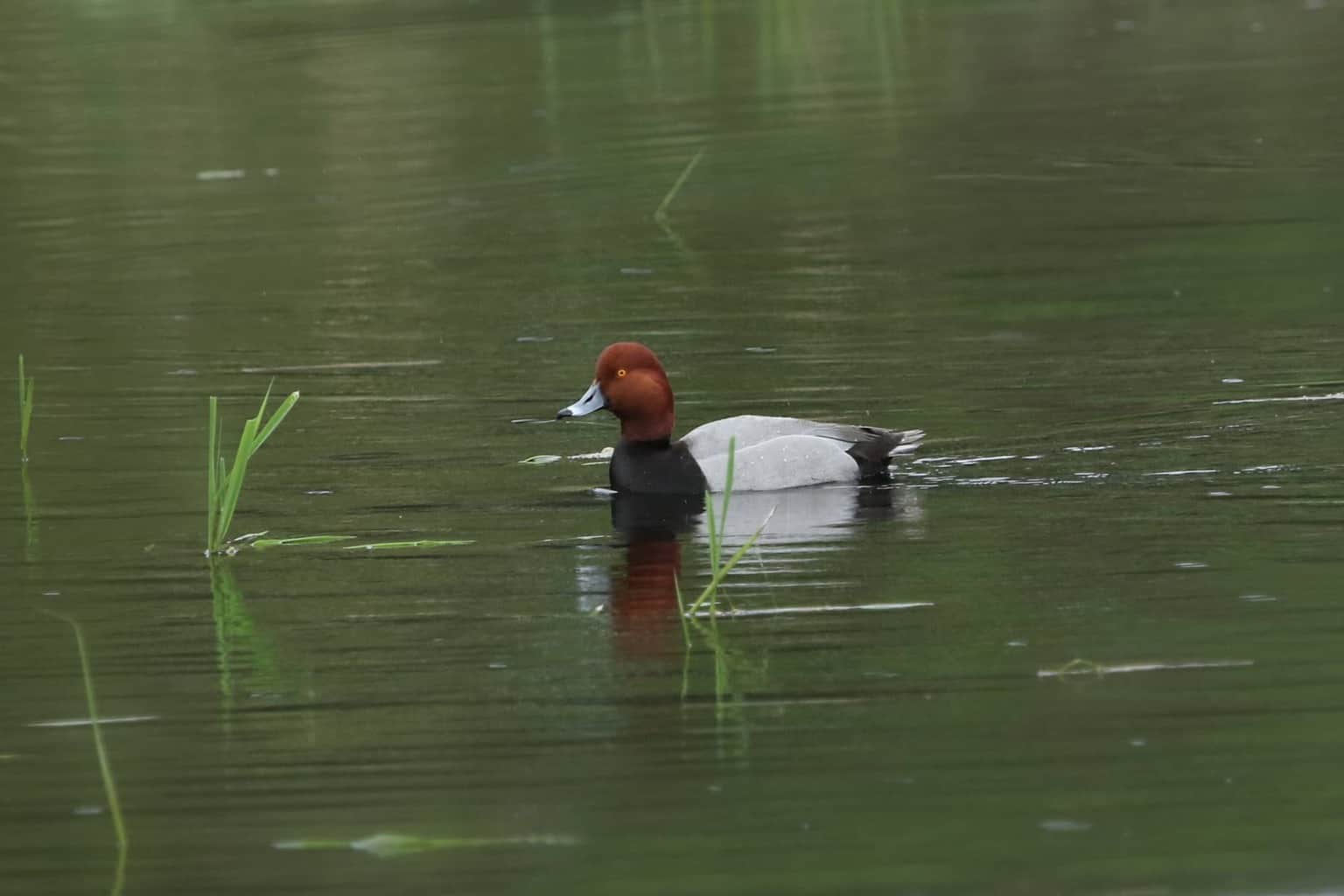
- Scientific Name: Aythya Americana
- Length: Between 16.5 and 21.3 inches
- Weight: Between 22.2 and 52.9 ounces
- Wingspan: Between 29.5 and 31.1 inches
The Redhead is a diving duck, and the males are larger than the females. Male Redheads have cinnamon heads and black breasts, while the females are usually brown.
You can find this bird around marshes, where it feeds on aquatic plants and algae. It also feeds on invertebrates that live around water bodies.
The males usually bend their necks to the back to attract the females.
Blue Birds in New Jersey
Indigo Bunting
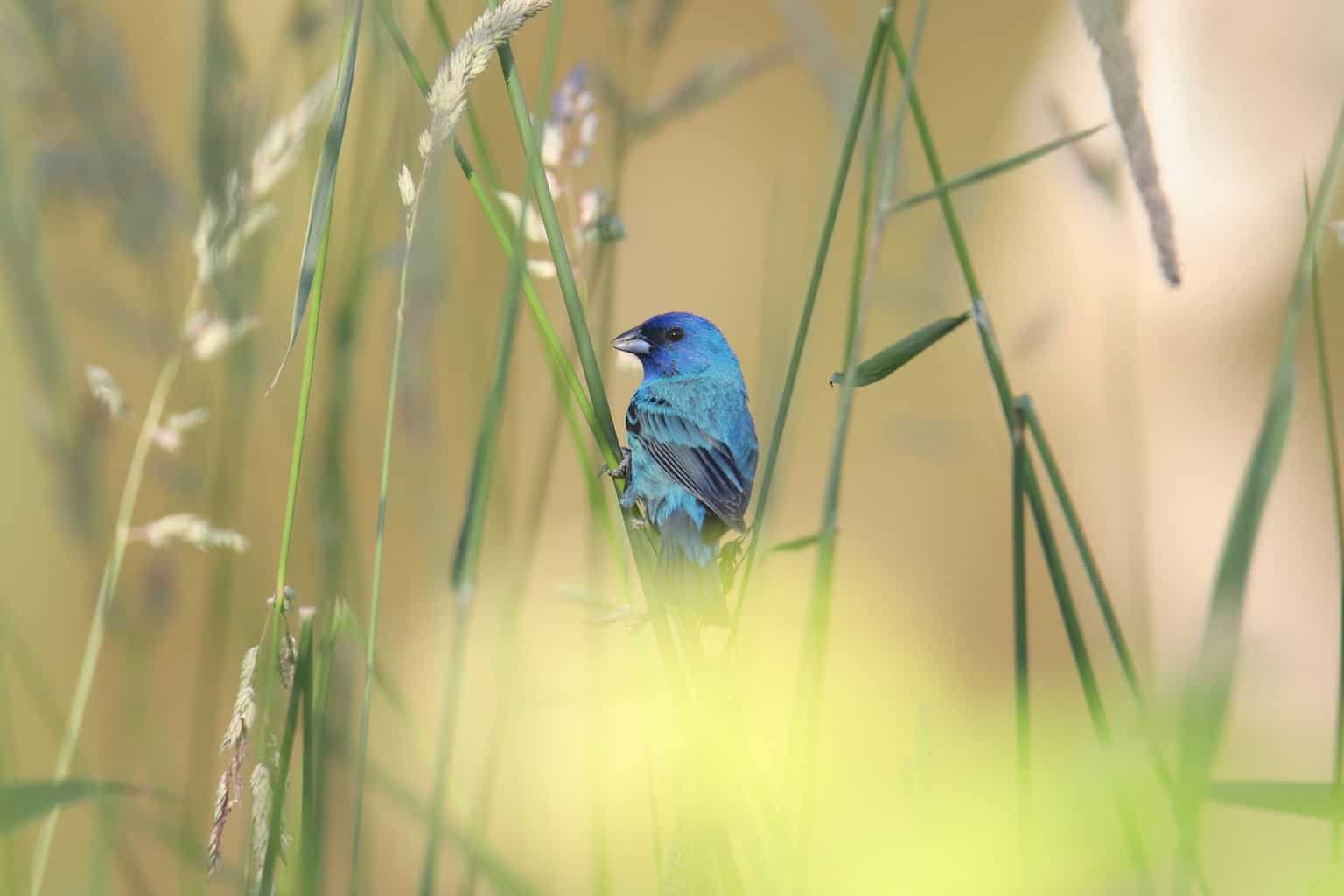
- Scientific Name: Passerina Cyanea
- Length: Between 4.5 and 5.9 inches
- Weight: About 0.5 ounces
- Wingspan: Between 7 and 9 inches
Indigo Buntings are found in summer, roaming the open forests or perching on roadside wires. Unfortunately, this bird is rather shy, so you’ll rarely see it in urban or suburban areas in New Jersey.
The male Indigo Bunting is bright blue with a deep shade of blue covering the head. Female birds have brown bodies with blue plumage on the chest.
It forages on seeds like thistles, dandelions, grains, berries and eats insects in the summer months.
Eastern Bluebird
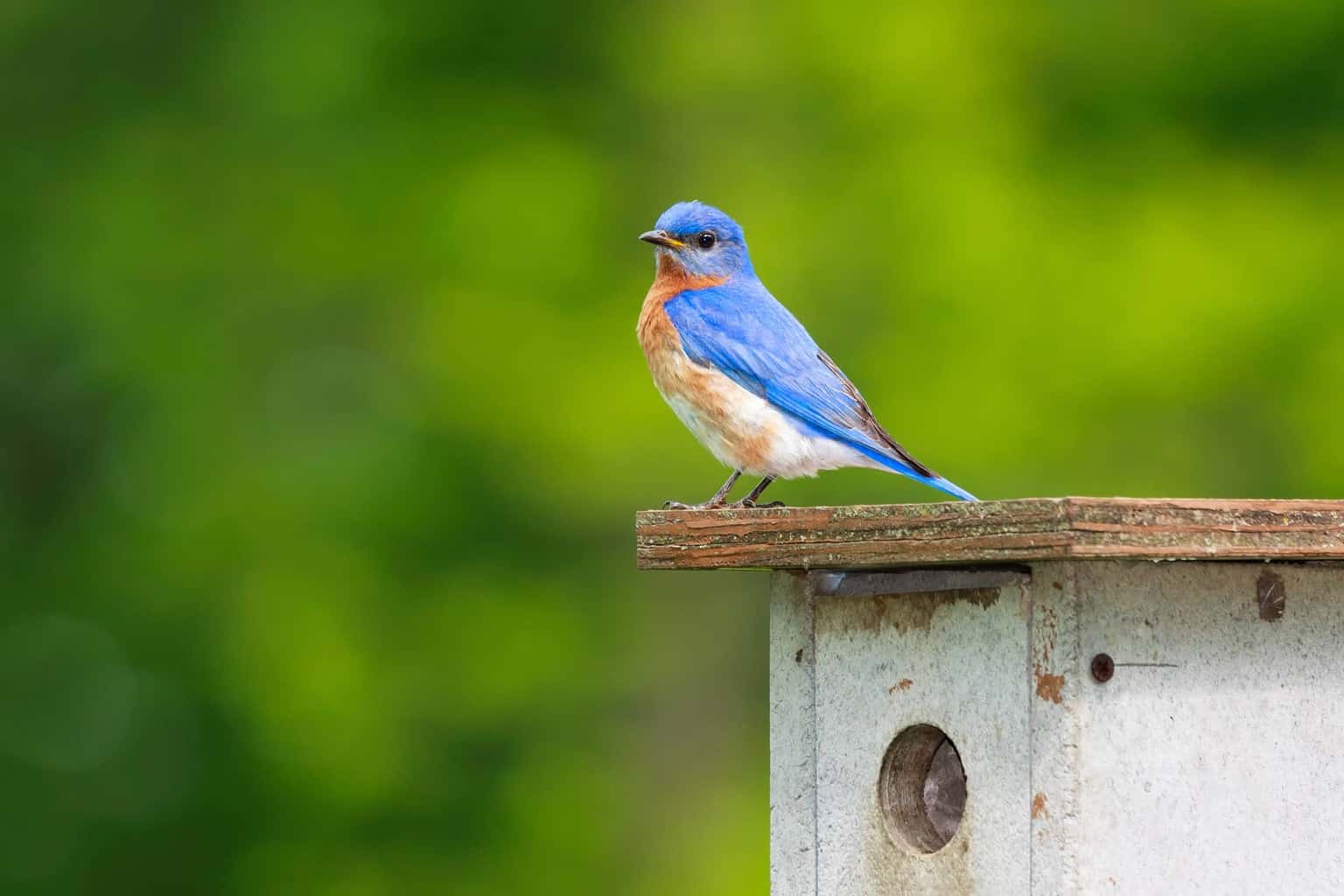
- Scientific Name: Sialia Sialis
- Length: Between 6.3 and 8.3 inches
- Weight: Between 0.95 and 1.2 ounces
- Wingspan: Between 9.8 and 12.6 inches
Birdwatchers can find the Eastern Bluebird in grassy areas with scattered trees, road edges, hedgerows, open fields, and the field edges of New Jersey. It can also be seen perching on roadside wires throughout the year.
In the past, the Eastern Bluebird population declined due to habitat loss, but this changed, and the bird can even be seen visiting your backyard if you offer mealworms.
This bird is easily recognized, thanks to its deep blue plumage. Male birds have rusty chests, while female birds have grayish bodies with blue feathers on the wings.
Green Birds in New Jersey
Mexican Violetear
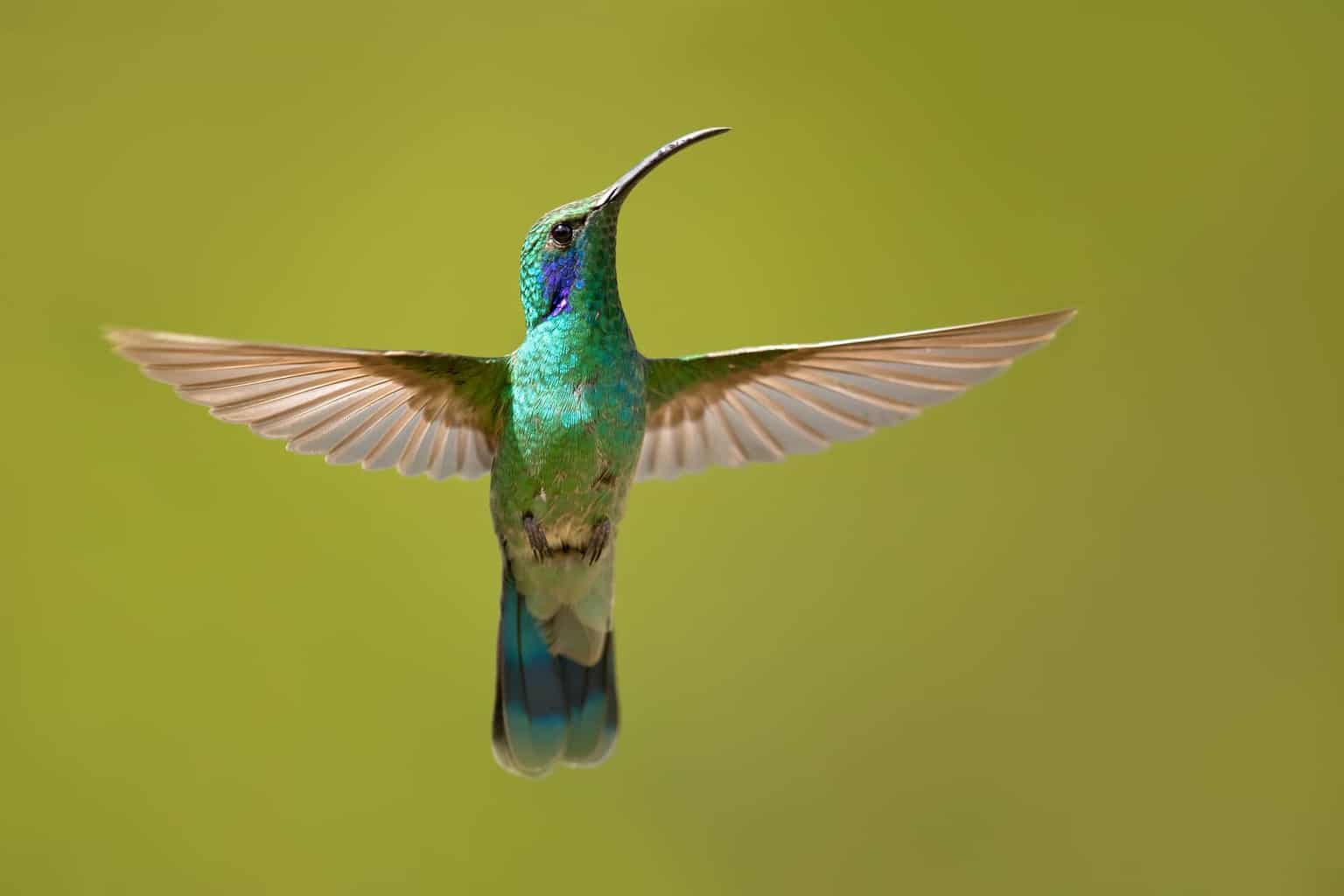
- Scientific Name: Colibri Thalassinus
- Length: Between 3.8 and 4.7 inches
- Weight: Between 0.17 and 0.2 ounces
- Wingspan: About 4.7 inches
The Mexican Violetear is a metallic green hummingbird with a glittering violet ear patch. Although this is one of the rarest birds to see in New Jersey, you might spot it if you have a hummingbird feeder in your backyard.
The birds prefer to forage alone but usually gather around flowering trees. It feeds on nectar and insects.
Violet-Green Swallow
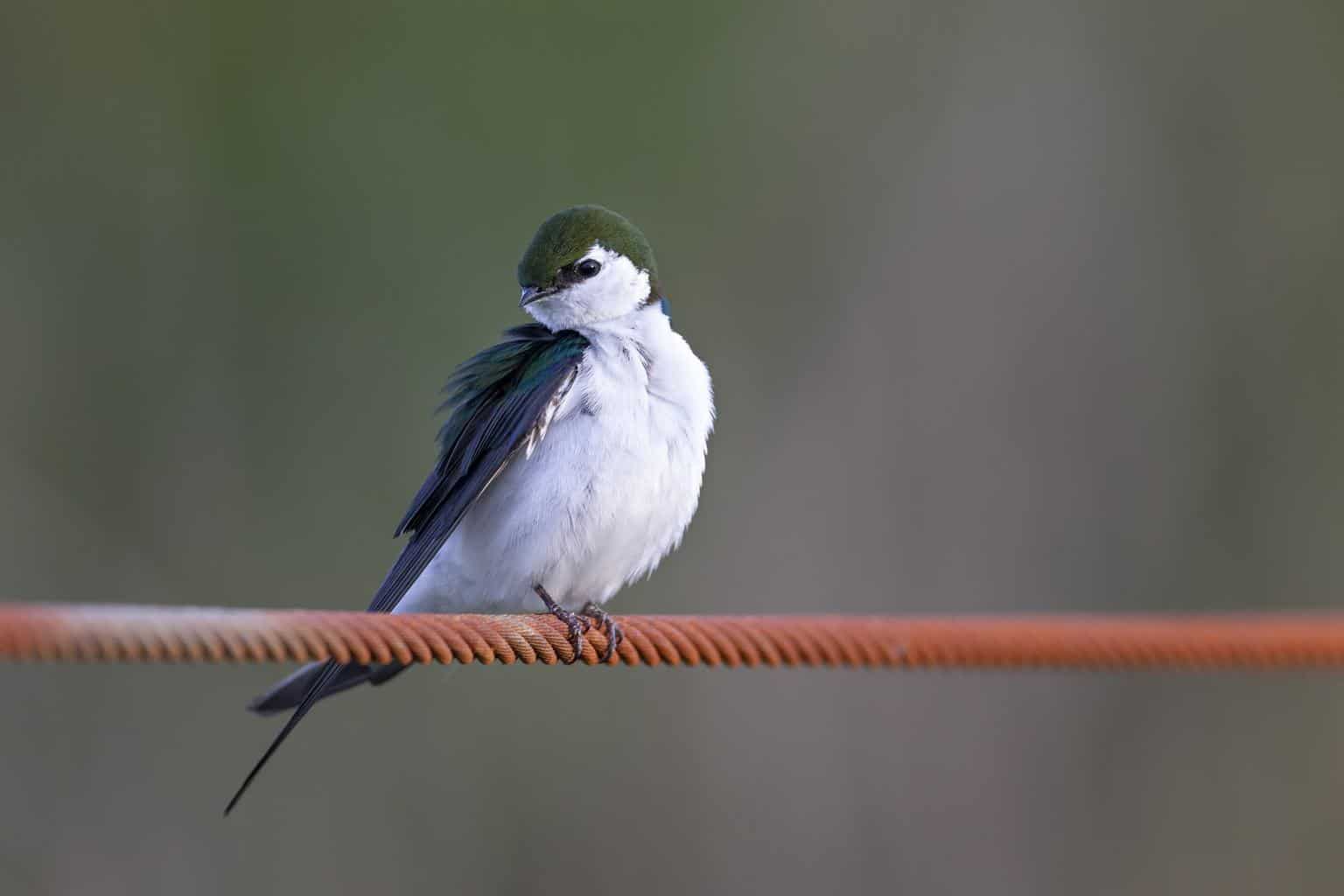
- Scientific Name: Tachycineta Thalassina
- Length: About 5 inches
- Weight: About 0.5 ounces
- Wingspan: About 10.6 inches
The Violet-green Swallow is commonly found in open habitats, feeding near the ponds or meadows of New Jersey. The bird has an interesting iridescent violet rump with an attractive green plumage that appears brighter in daylight.
Female and younger birds have dusky cheeks and paler bodies. The Violet-green Swallow is usually seen flying at high elevations and can build its nests close to buildings.
You might be able to attract a pair to your backyard if you set up a nesting box during the mating season.
Monk Parakeet
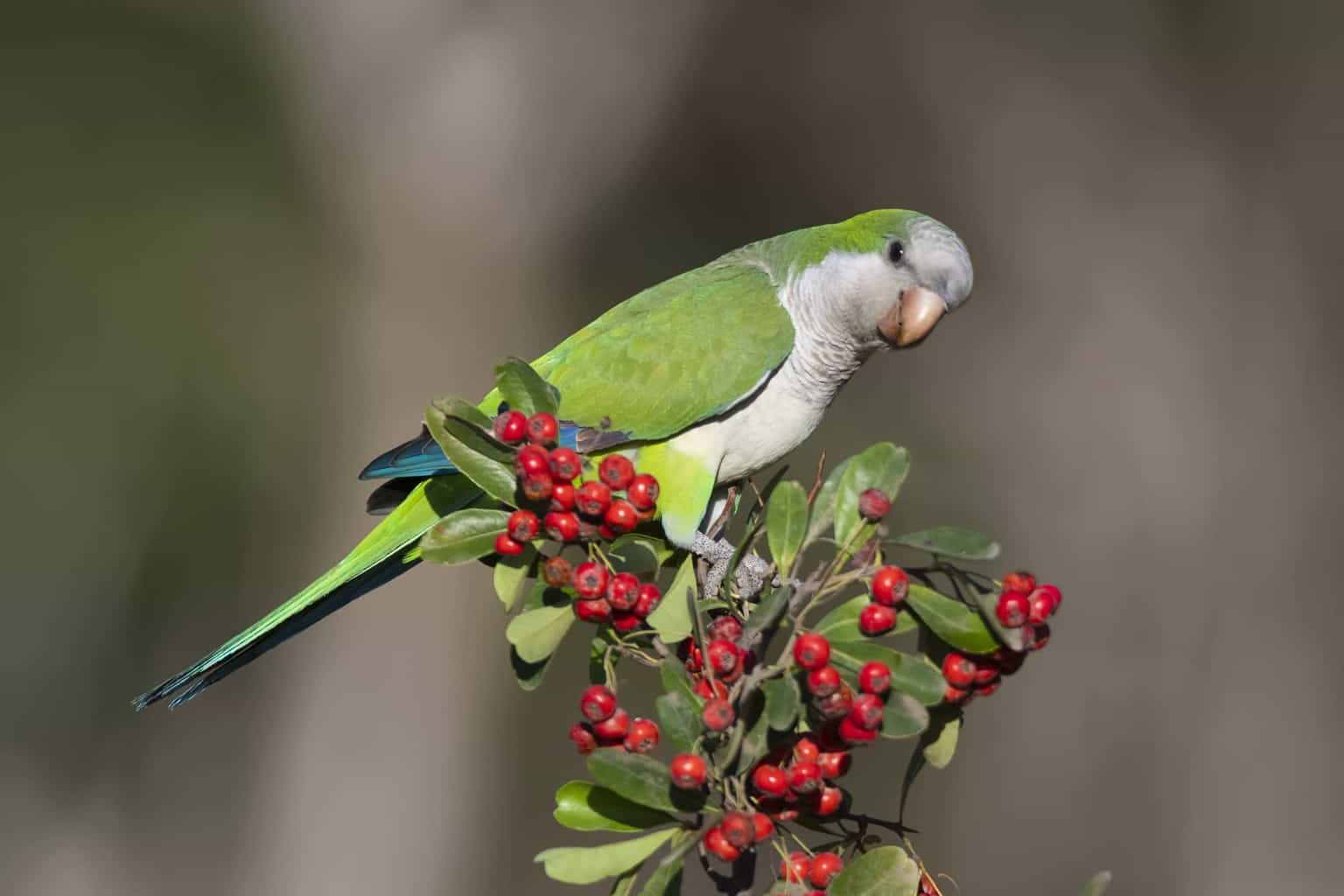
- Scientific Name: Myiopsitta Monachus
- Length: About 11 inches
- Weight: About 3.5 ounces
- Wingspan: About 19 inches
Although the Monk Parakeet is native to South America, it’s been a resident of northern New Jersey for the past 30 years. The bird has a green body with a gray face and breast.
The birds nest in large communities all year long, building their stick nests on power poles and in trees. It eats buds, seeds, berries, blossoms, and nuts.
In winter, the Monk Parakeet will visit your backyard if you have a birdfeeder. Sadly, some New Jersey residents think this bird is problematic because it damages utility lines and soils cars.
Green Heron
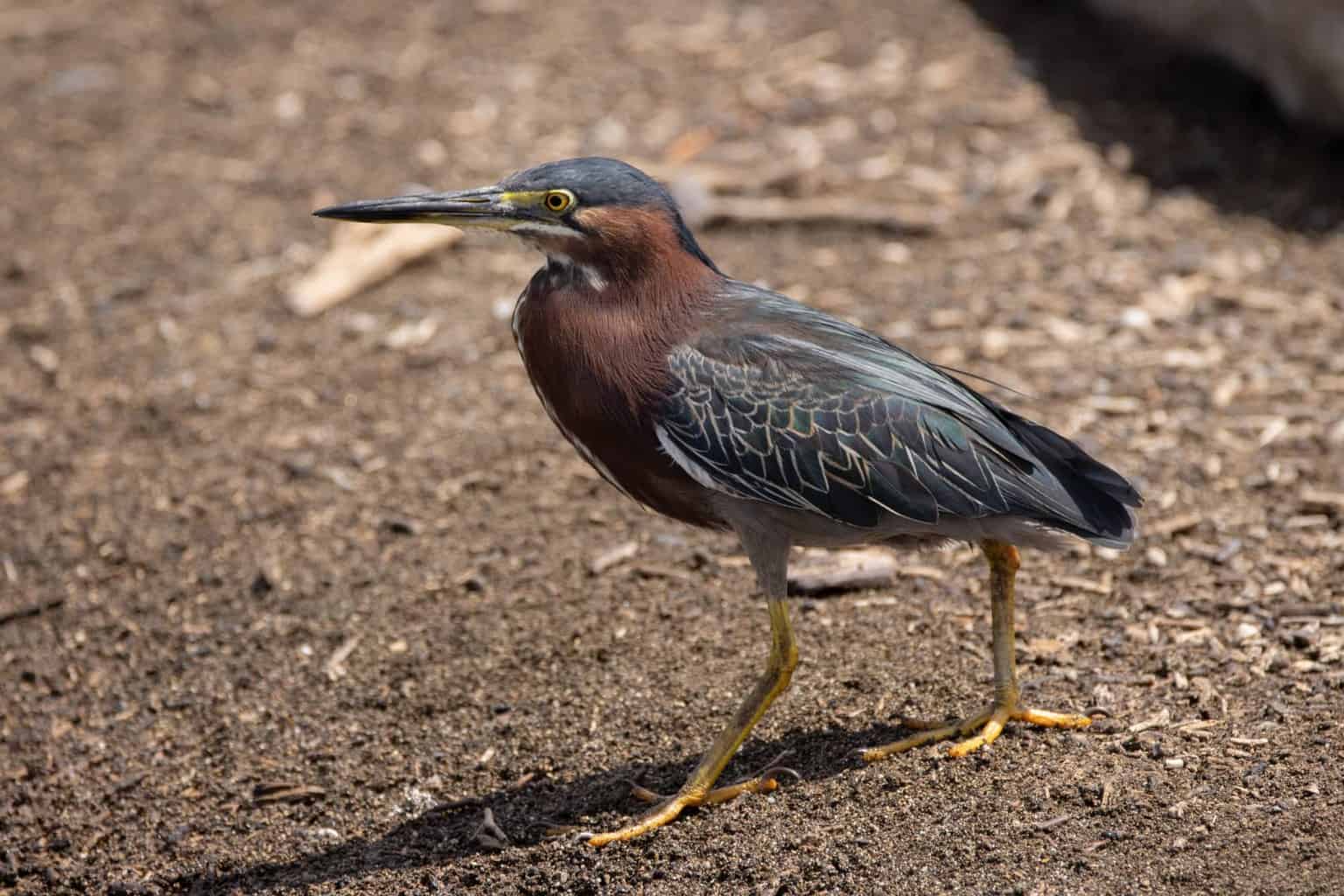
- Scientific Name: Butorides Virescens
- Length: Between 16 and 18 inches
- Weight: About 8.5 ounces
- Wingspan: Between 25.2 and 26.8 inches
The Green Heron is found in the wet habitats of New Jersey, as long as there’s dense vegetation that provides the perfect hiding spot for the bird.
This is a stocky bird with a bright velvet-green back, chestnut body, and yellow legs. It uses twigs and feathers to lure fish and amphibians in marshes and ponds, catching them with its dagger-like bill.
Black-Throated Green Warbler
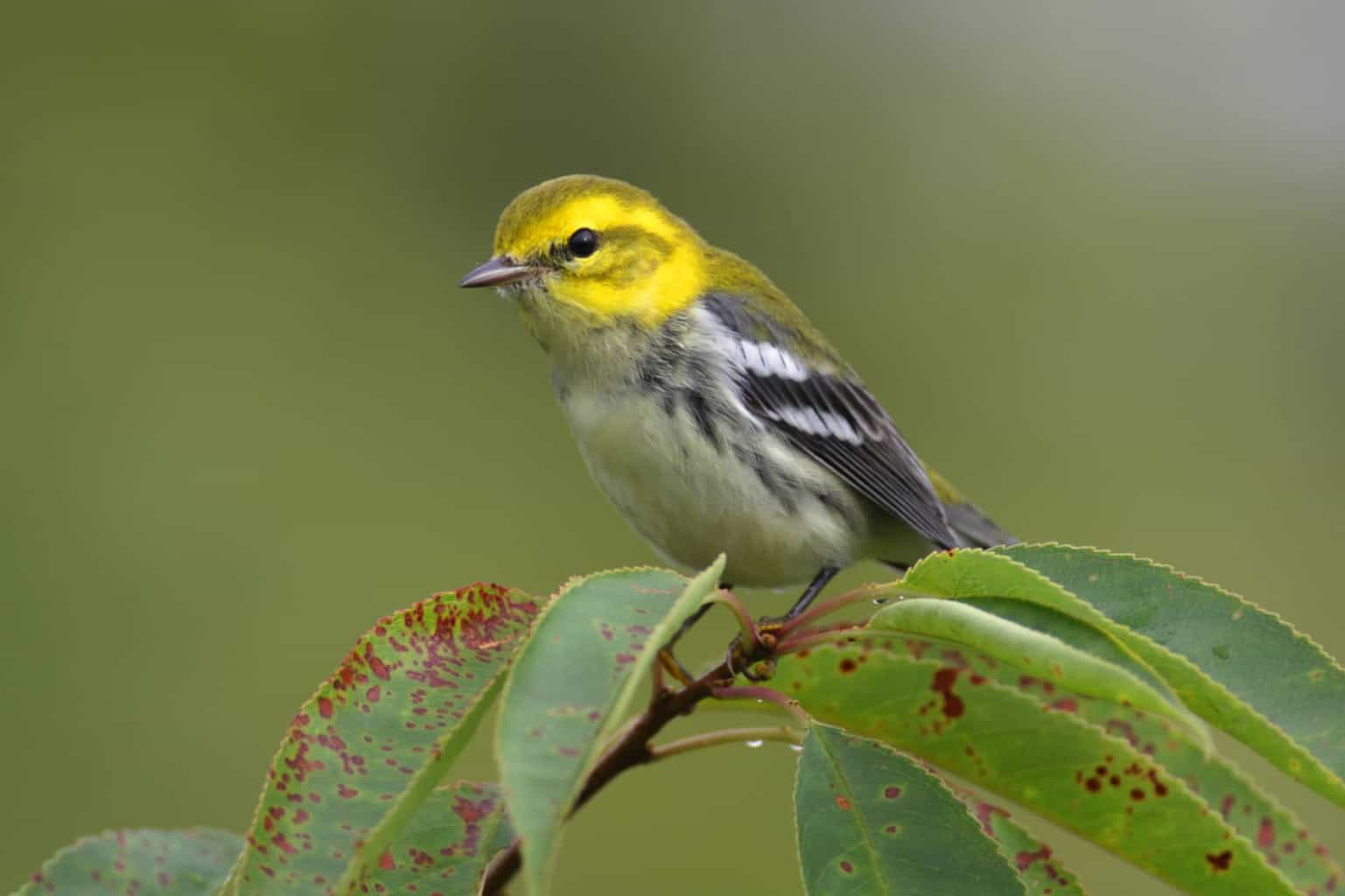
- Scientific Name: Setophaga Virens
- Length: Between 4.3 and 4.7 inches
- Weight: Between 0.3 and 0.4 ounces
- Wingspan: Between 6.7 and 7.9 inches
The Black-Throated Green Warbler has an olive-green body with a black front and yellow face. This bird forages for insects hiding in the bases of tall trees.
The bird’s famous song makes it noticeable to birdwatchers in the breeding season. Birders follow the ringing song to locate the bird as it usually remains high in the canopy.
Male birds are usually aggressive when they’re defending their territories. In winter, Black-Throated Green Warblers join flocks of other tropical species.
Orange Birds in New Jersey
Allen’s Hummingbird
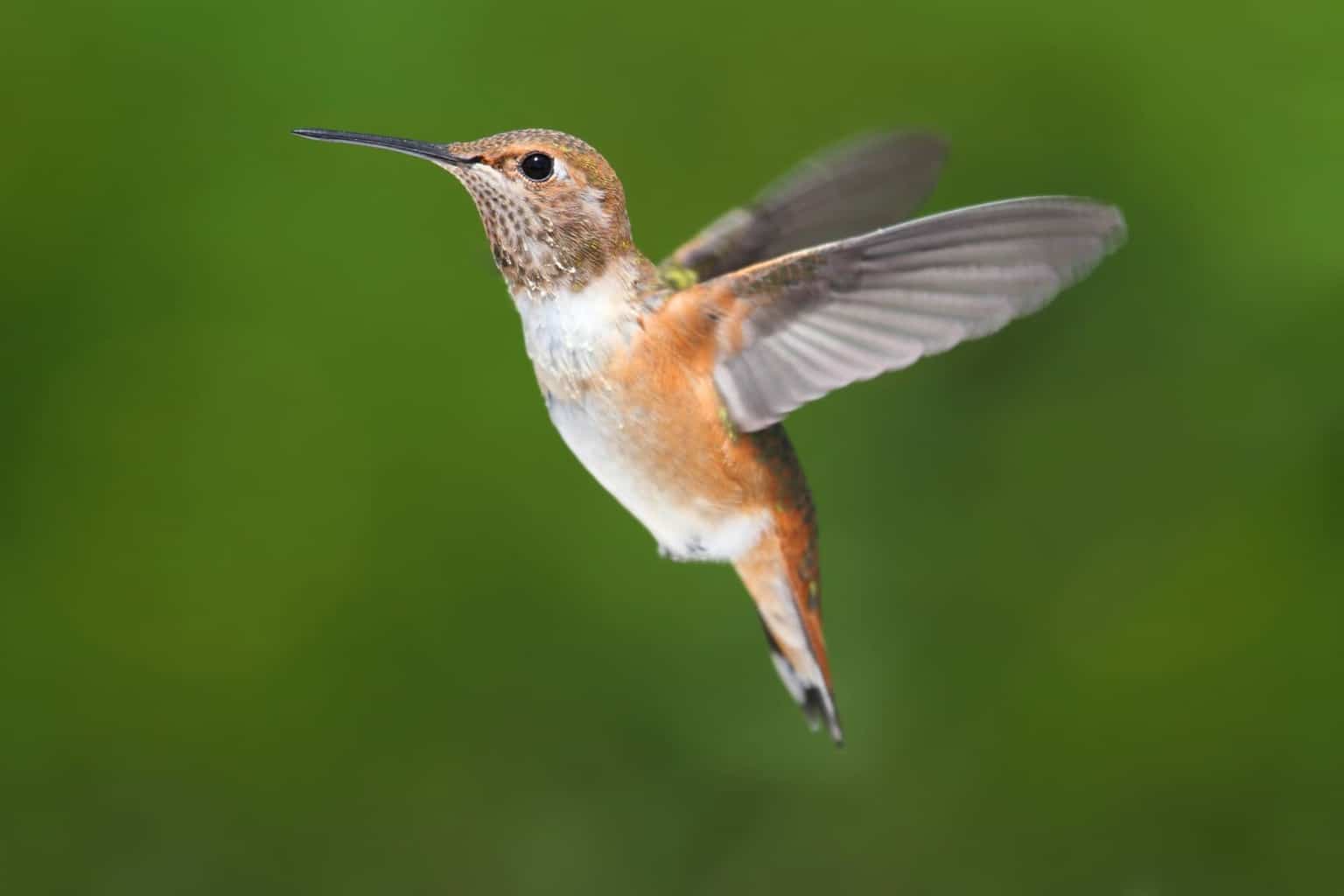
- Scientific Name: Selasphorus Sasin
- Length: Between 3 and 3.5 inches
- Weight: About 0.1 ounces
- Wingspan: About 4.3 inches
Allen’s Hummingbird can be found near Cape May and Toms River. It’s a coppery orange bird with green feathers and a deep orange gorget.
Just like other hummingbirds, it feeds on nectar or catches insects while they’re flying. Allen’s Hummingbird moves back and forth in a pendulum-like movement that produces a bumblebee-like buzz.
You can attract this bird to your backyard by setting up a hummingbird feeder.
Rufous Hummingbird
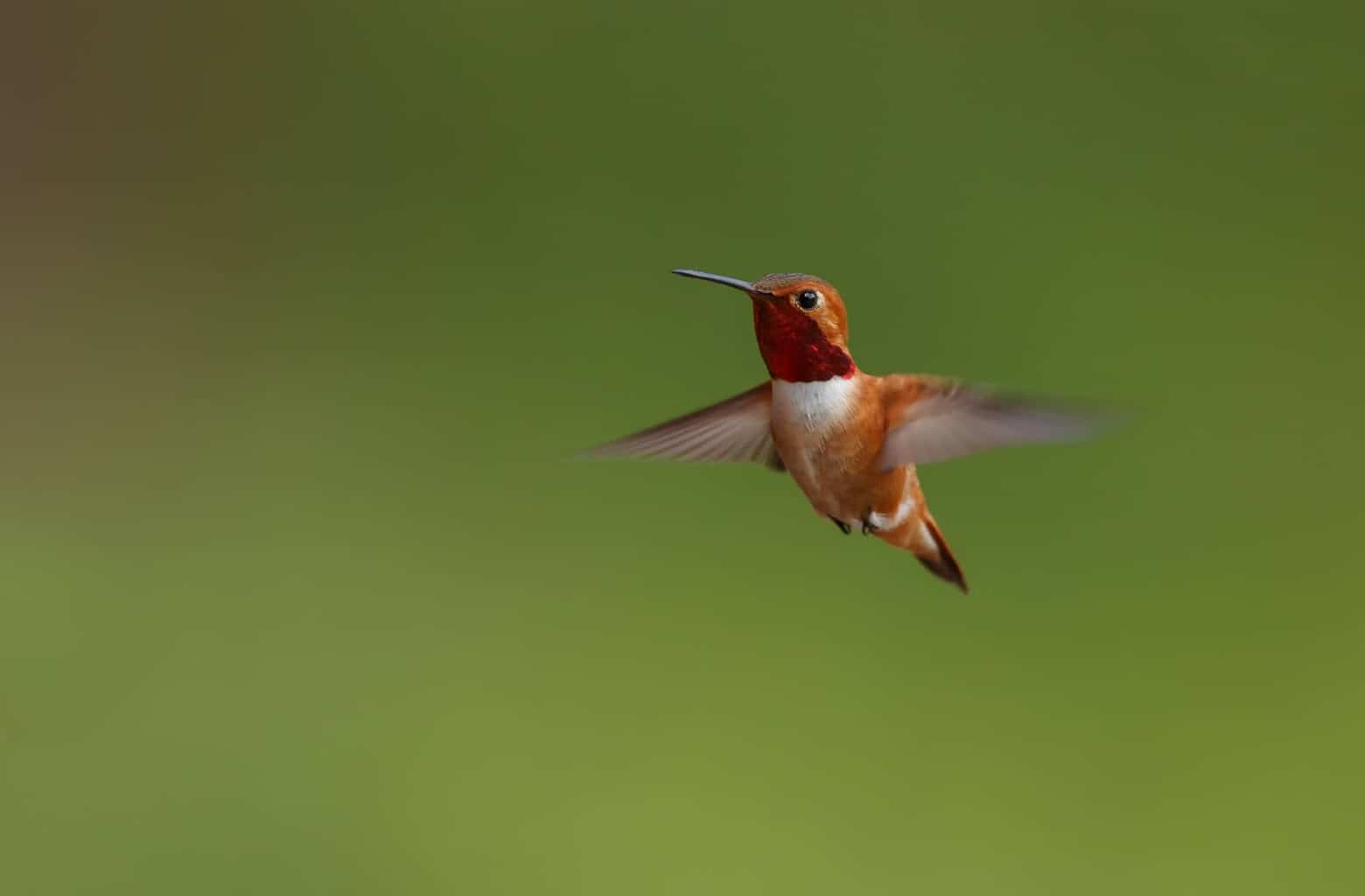
- Scientific Name: Selasphorus Rufus
- Length: Between 2.8 and 3.5 inches
- Weight: Between 0.071 and 0.176 ounces
- Wingspan: About 4.3 inches
The Rufous Hummingbird arrives in New Jersey in April or May and stays near gardens and backyard feeders until September.
The male bird has a bright orange back and belly, while the female bird has greenish upperparts with some rufous patches on the tail.
Because of its continuous activity and fast motion, this bird needs to feed regularly and will most likely chase larger birds and rodents at feeders.
The Rufous Hummingbird feeds on tubular flowers and eats insects to provide its body with the needed proteins and fats. Male birds usually mate with multiple female birds.
Yellow Birds in New Jersey
American Goldfinch
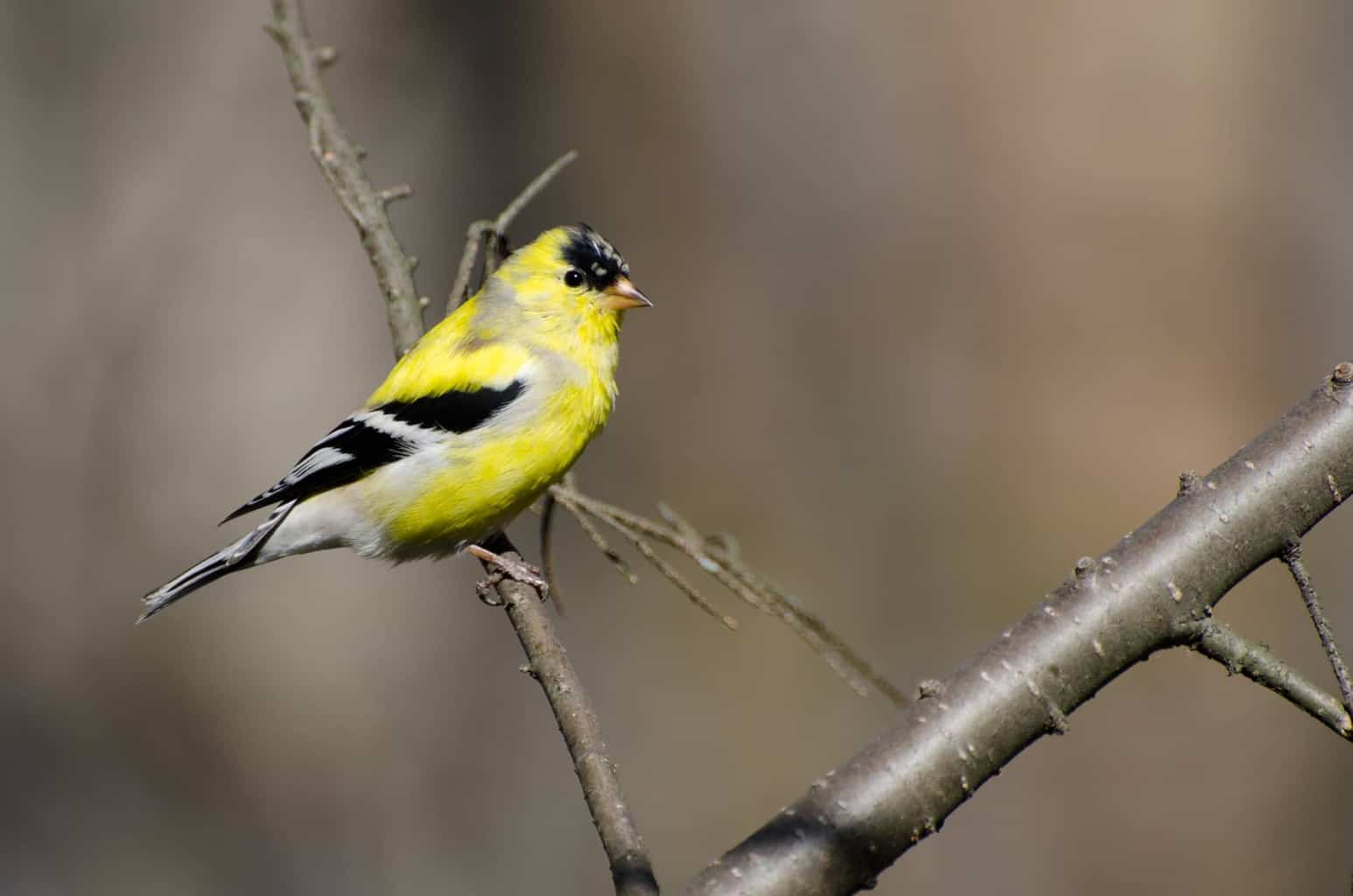
- Scientific Name: Spinus Tristis
- Length: Between 4.3 and 5.5 inches
- Weight: Between 0.39 and 0.71 ounces
- Wingspan: Between 7.5 and 8.7 inches
The American Goldfinch is the state bird of New Jersey and is abundantly found in the Garden State. It’s a common feeder bird and will visit your backyard if you set up a bird feeder or plant native thistles and milkweed, as it primarily feeds on seeds.
The male bird has a bright yellow body with black wings and black forehead, while the female bird has a paler body with olive upperparts and yellowish underparts.
This bird is active and is known for its acrobatic bouncy flying pattern. Unlike other songbirds, the American Goldfinch doesn’t engage in the behavior of mobbing predators.
Yellow-Rumped Warbler
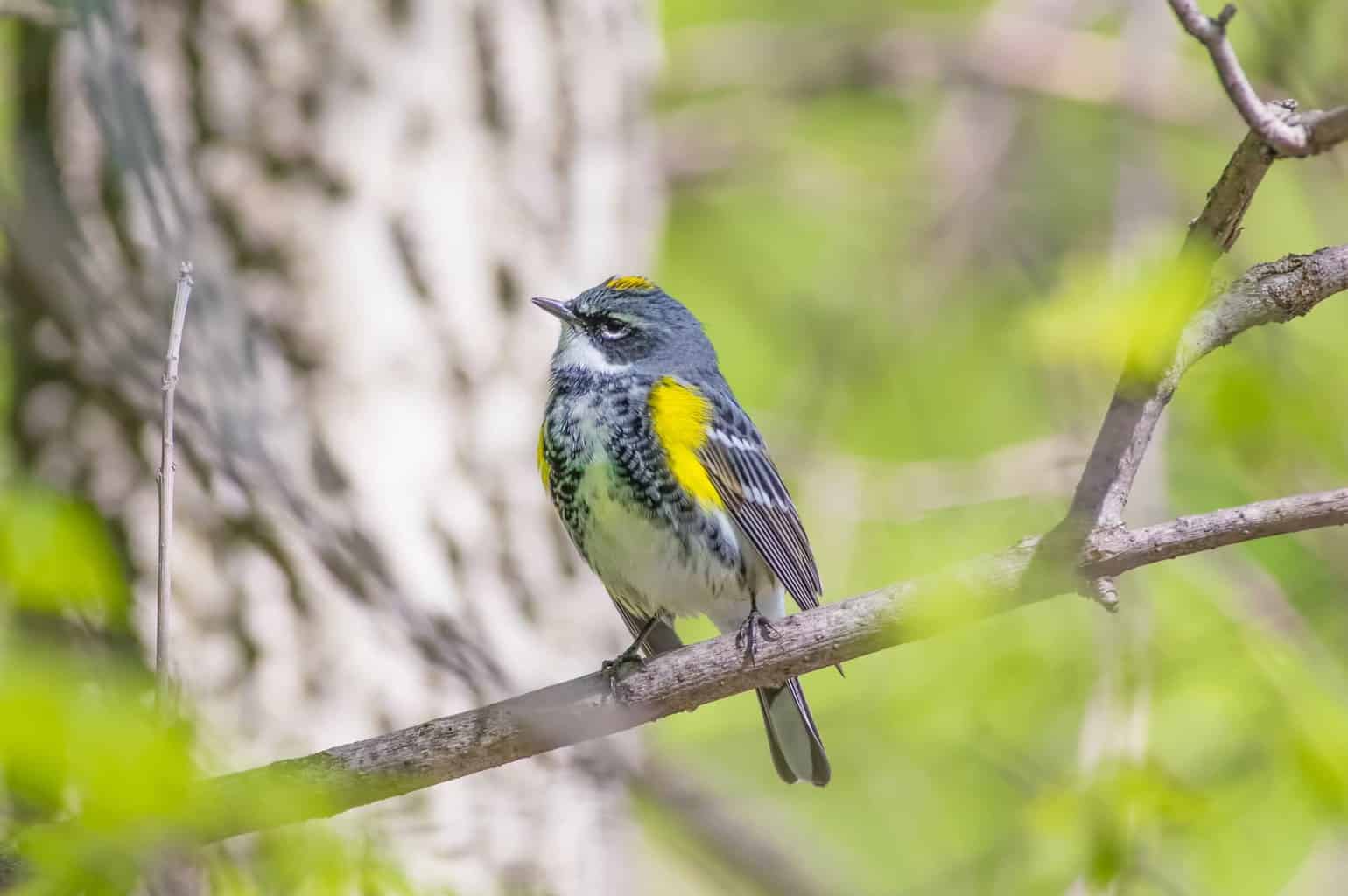
- Scientific Name: Setophaga Coronata
- Length: Between 4.7 and 5.5 inches
- Weight: Between 0.4 and 0.5 ounces
- Wingspan: Between 7.5 and 9.1 inches
This bird has a yellow face with gray and white wing bars. Female birds have duller color plumage with some hints of brown.
Unlike other warblers, the Yellow-Rumped Warbler can digest the waxes found in bayberries and wax myrtles. This gives the bird the energy to winter further in the north.
It prefers to perch on trees in the summer and will visit your backyard in winter if you set up a bird feeder. You need to fill your bird feeder with peanut butter, suet, safflower seeds, and black oil sunflower seeds.
Other Birds to Watch For In New Jersey
Painted Bunting

- Scientific Name: Passerina Ciris
- Length: Between 4.7 and 5.5 inches
- Weight: Between 0.46 and 0.67 ounces
- Wingspan: Between 8.3 and 9.1 inches
The Painted Bunting is a rare bird found in northern New Jersey. The male birds have brightly colored blue heads, red underpants, and green backs, while female birds are bright green overall.
The bird usually forages in dense grass and can sometimes be seen feeding at seed feeders.
Although the Painted Bunting feeds on seeds all year long, it switches to insects during the breeding season. It can sometimes be seen foraging in trees as high as 30 feet off the ground, usually catching prey from spider webs.
American Robin
- Scientific Name: Turdus migratorius
- Length: Between 9 and 11 inches
- Weight: About 2.7 ounces
- Wingspan: Between 12 and 16 inches
The American Robin is one of the most common songbirds in New Jersey and can be found everywhere, from the high elevations in the west to the sea-level territories around the East Coast.
In winter, American Robins spend most of their time in trees, and in summer, the birds usually fight over worms.
The American Robin is a large bird with a gray-brown body with warm orange underparts and a gray tail. Females have paler heads than male birds, which have dark heads.
Birdwatchers can find this popular backyard bird in gardens, parks, yards, golf courses, chasing worms in your backyard, or feeding at a bird feeder.
American Purple Gallinule
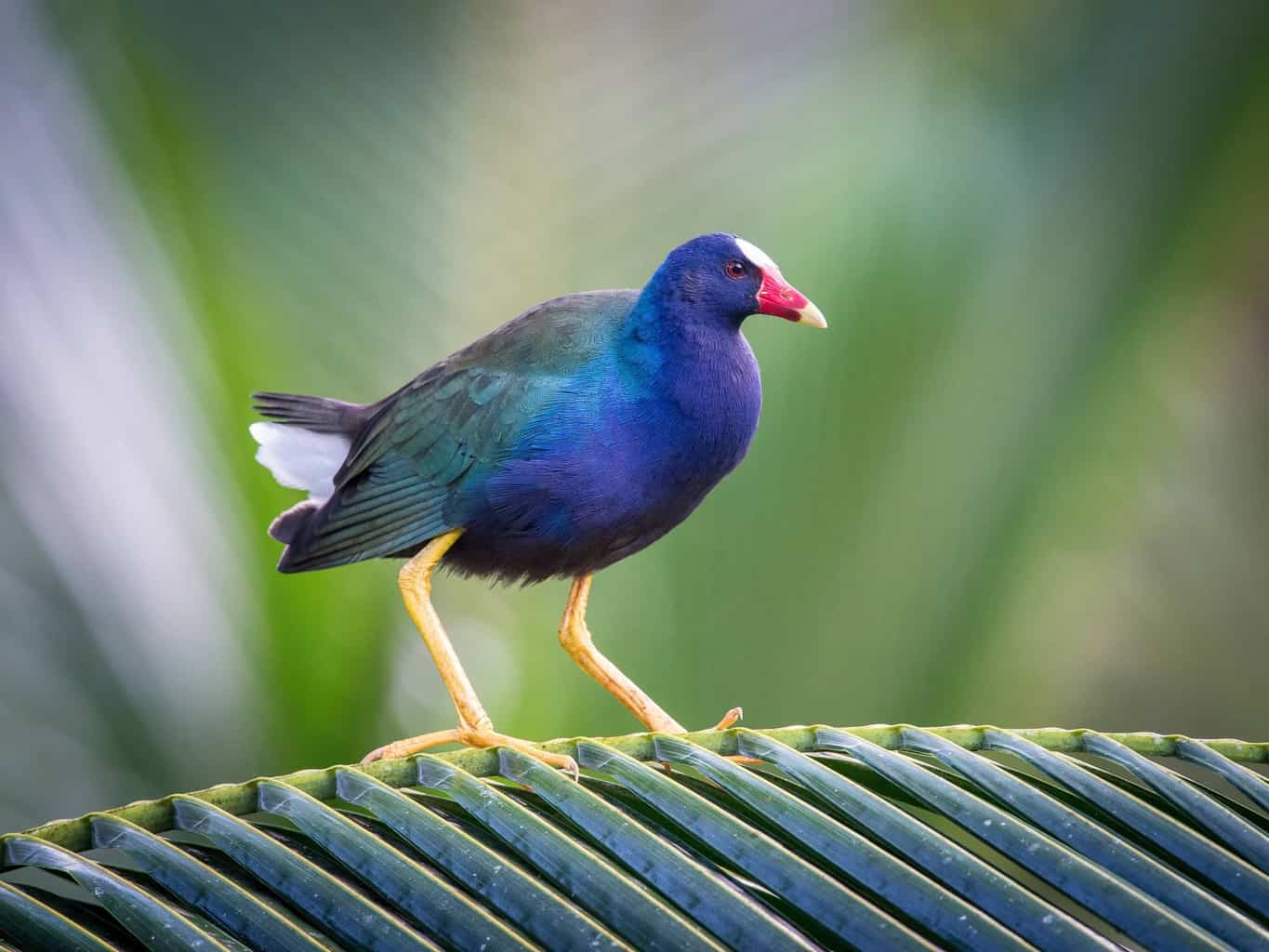
- Scientific Name: Porphyrio Martinicus
- Length: Between 10 and 15 inches
- Weight: Between 5 and 10.8 ounces
- Wingspan: Between 20 and 24 inches
The Purple Gallinule can be found in the marshes of New Jersey, especially where there’s a lot of emergent vegetation. It has a bright bluish-purple body with a green back and long yellow legs.
This chicken-sized bird forages near the water’s edge, walking on the muddy margins or aquatic vegetation. It feeds on aquatic plants, flowers, fruits, and seeds of aquatic plants.
The bird is usually found alone and is known for its loud vocalization.
European Starling
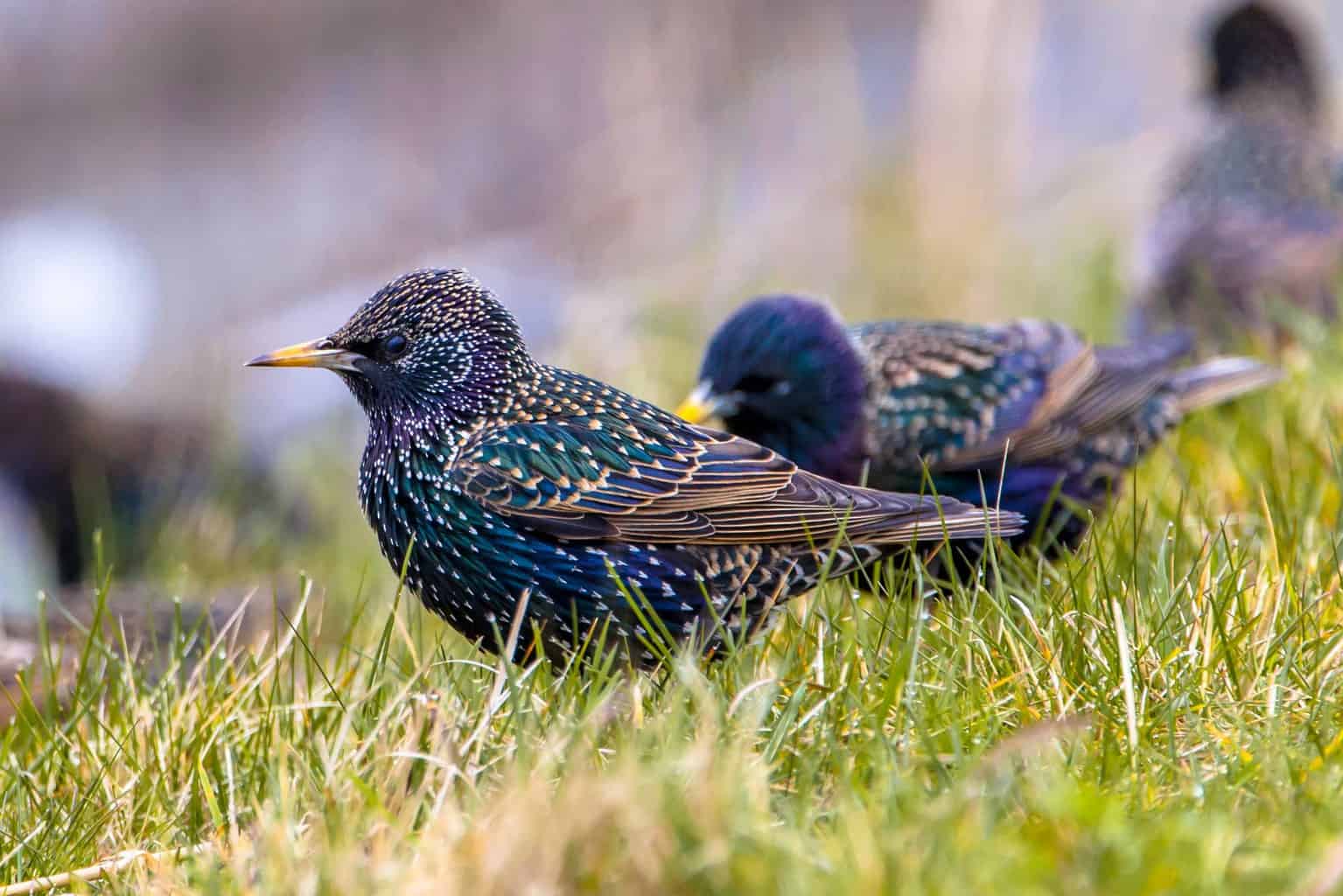
- Scientific Name: Sturnus Vulgaris
- Length: Between 7.5 and 9.1 inches
- Weight: Between 2 and 3.6 ounces
- Wingspan: Between 12 and 17 inches
The European Starling has a shimmering purplish-green plumage that looks black from a distance.
It’s a non-native aggressive bird that is considered an invasive species in New Jersey, usually considered a nuisance as it imitates the songs of other native birds, cellphone sounds, and car horns.
The bird also nests in phone boxes and electricity boxes, causing communication problems and fires.
European Starlings are a common visitor among people and will eat anything, including insects and invertebrates. They also eat fruits, grains, livestock feed, nectar, and even garbage.
Tufted Titmouse
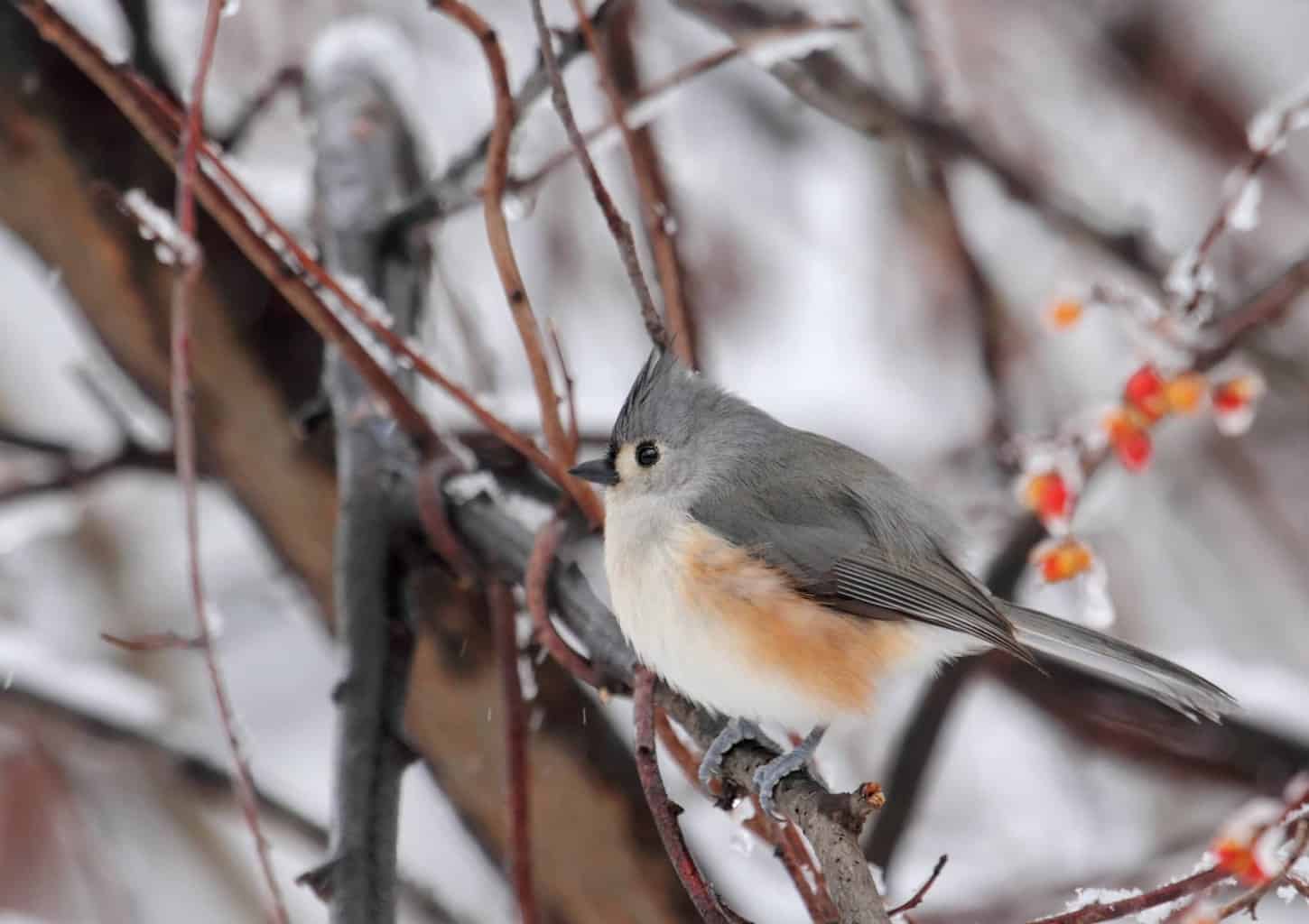
- Scientific Name: Baeolophus Bicolor
- Length: Between 5.5 and 6.3 inches
- Weight: Between 0.6 and 0.9 ounces
- Wingspan: Between 7.9 and 10.2 inches
This little acrobatic bird is commonly found in deciduous forests and farmlands of New Jersey. It has soft silvery-gray upperparts and white underparts with a black patch above the bill.
The Tufted Titmouse usually travels with other birds like woodpeckers and bullies smaller birds at bird feeders. You can attract a breeding pair to your backyard by setting up a nesting box.
The Tufted Titmouse feeds on insects in the summer, especially ants, wasps, and caterpillars. In winter, it feeds on nuts, berries, grains, and acorns.
Eastern Screech Owl
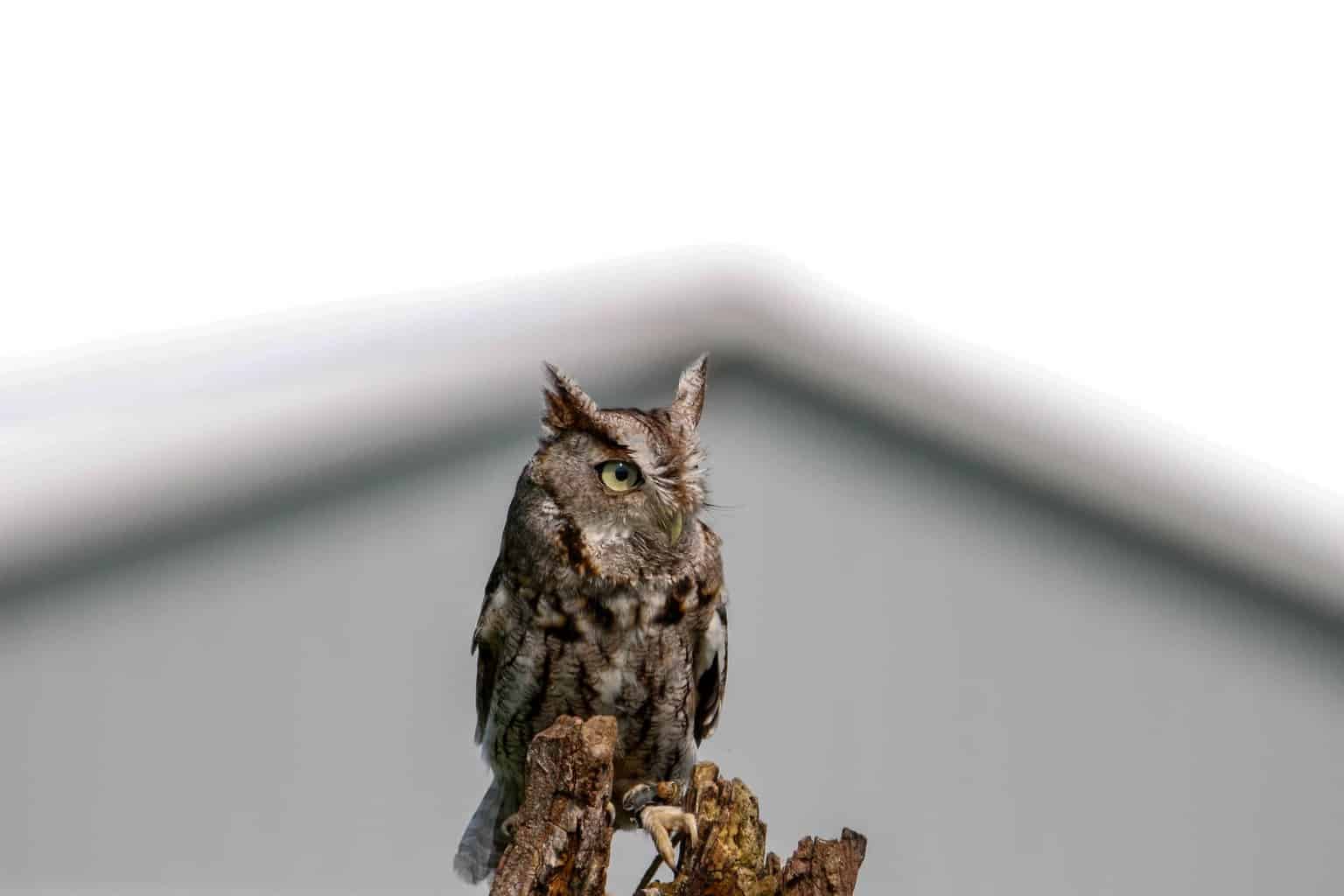
- Scientific Name: Megascops Asio
- Length: Between 6.3 and 9.8 inches
- Weight: Between 4.3 and 8.6 ounces
- Wingspan: Between 18 and 24 inches
The Eastern-Screech Owl is found in the farmlands and suburban landscapes of New Jersey. It’s a small owl with reddish-gray plumage and yellow eyes.
It spends most of its time hiding in cavities, and the plumage provides the perfect camouflage.
Most bird watchers find that this owl is easier heard than seen. It feeds on small mammals, birds, rodents, earthworms, and frogs.
In some cases, the owl will store food in tree holes or display cannibalistic behavior.
Pileated Woodpecker
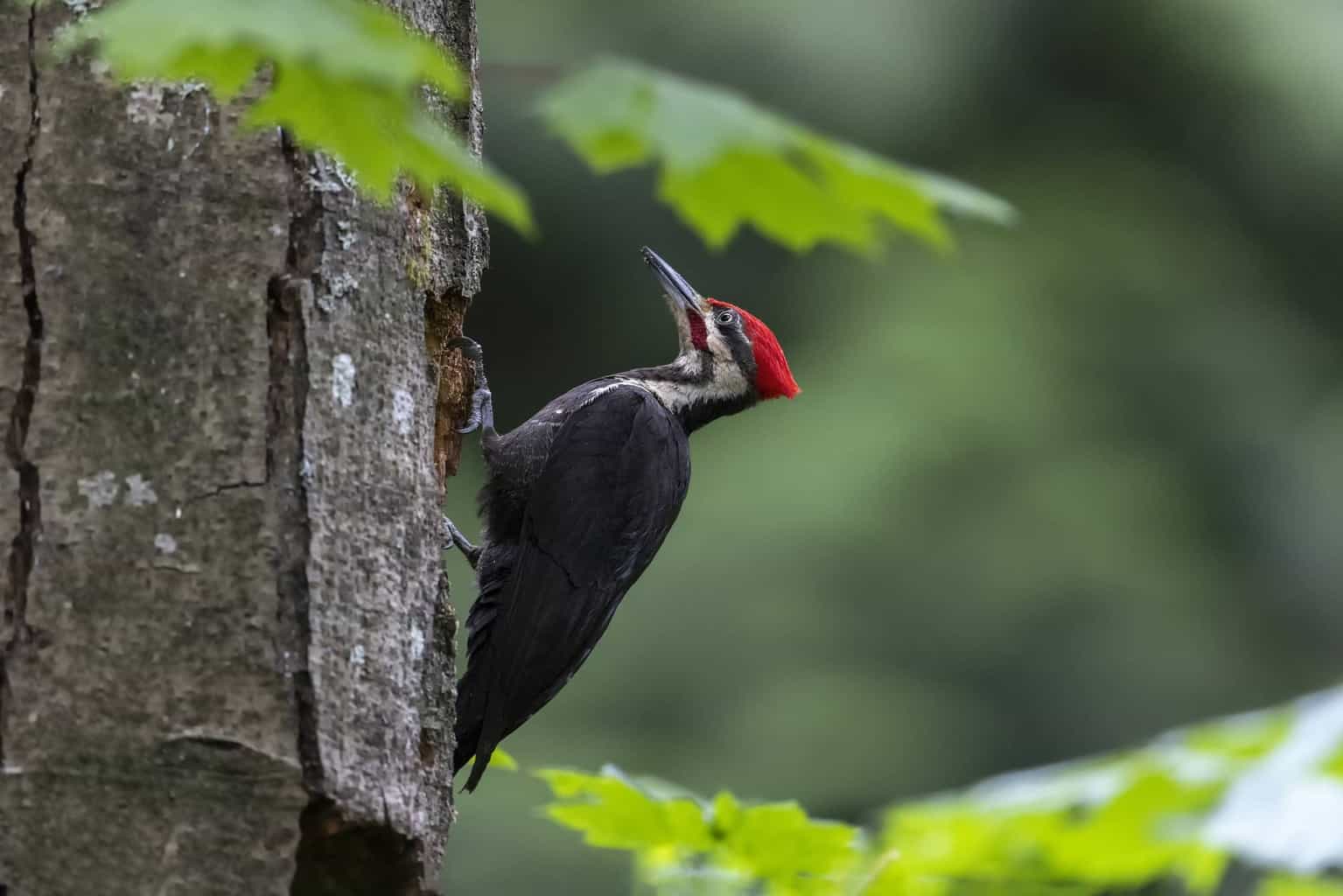
- Scientific Name: Dryocopus Pileatus
- Length: Between 16 and 19 inches
- Weight: Between 9 and 14 ounces
- Wingspan: Between 26 and 30 inches
This is the largest woodpecker in New Jersey and can be found all year long. The woodpecker has a black body with white markings and a flaming red crest.
The Pileated Woodpecker digs broad rectangular holes to excavate for carpenter ants. It will be a regular visitor in your backyard if you set up a bird feeder and fill it with suet.
If you have a dying tree in the backyard, it will also be a great attraction to Pileated Woodpeckers.
Northern Harrier

- Scientific Name: Circus Hudsonius
- Length: Between 18.1 and 19.7 inches
- Weight: Between 10.6 and 26.5 ounces
- Wingspan: Between 40.2 and 46.5 inches
Unlike other hawks, the Northern Harrier has an owl-like body and a long tail. It relies on its acute hearing as well as its vision when it’s catching its prey.
Male hawks are primarily gray, and the females are brown. The hawk’s eyes change color when it reaches maturity.
Also known as the Marsh Hawk, the Northern Harrier can be found in grasslands, meadows, emergent wetlands, and even airports. It usually feeds on mammals, reptiles, amphibians, and birds.
Conclusion
The natural geography and topography features of New Jersey create the perfect habitat for a widely varied bird population all year long.
Most of your favorite birds are easier to find during spring and summer, but some of them are year-round residents, so you can also enjoy their presence in winter.
So, next time you’re exploring a park, a marsh, or taking a walk in the neighborhood, you’ll most likely encounter a curious bird that might be trying to catch your attention.


